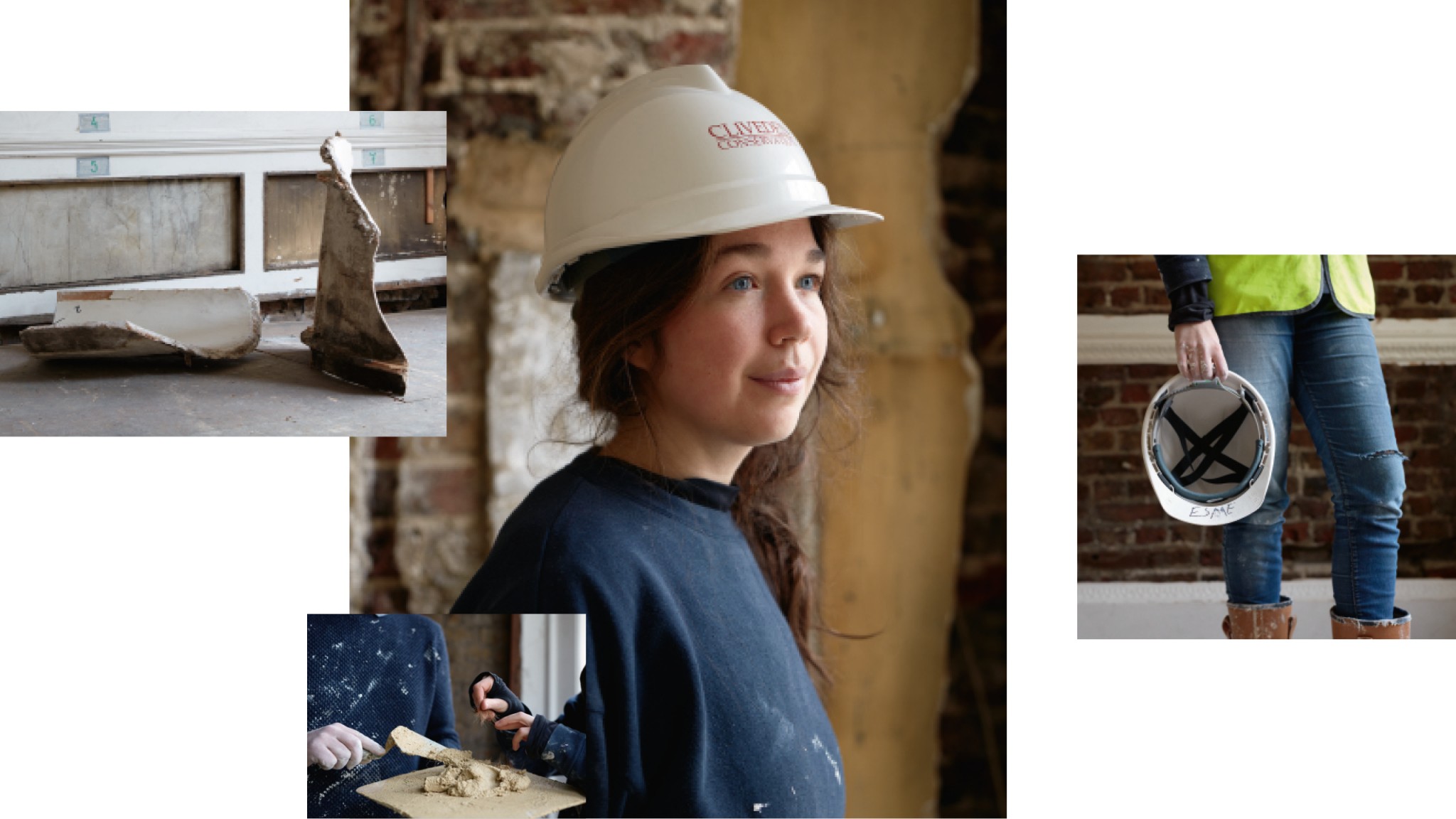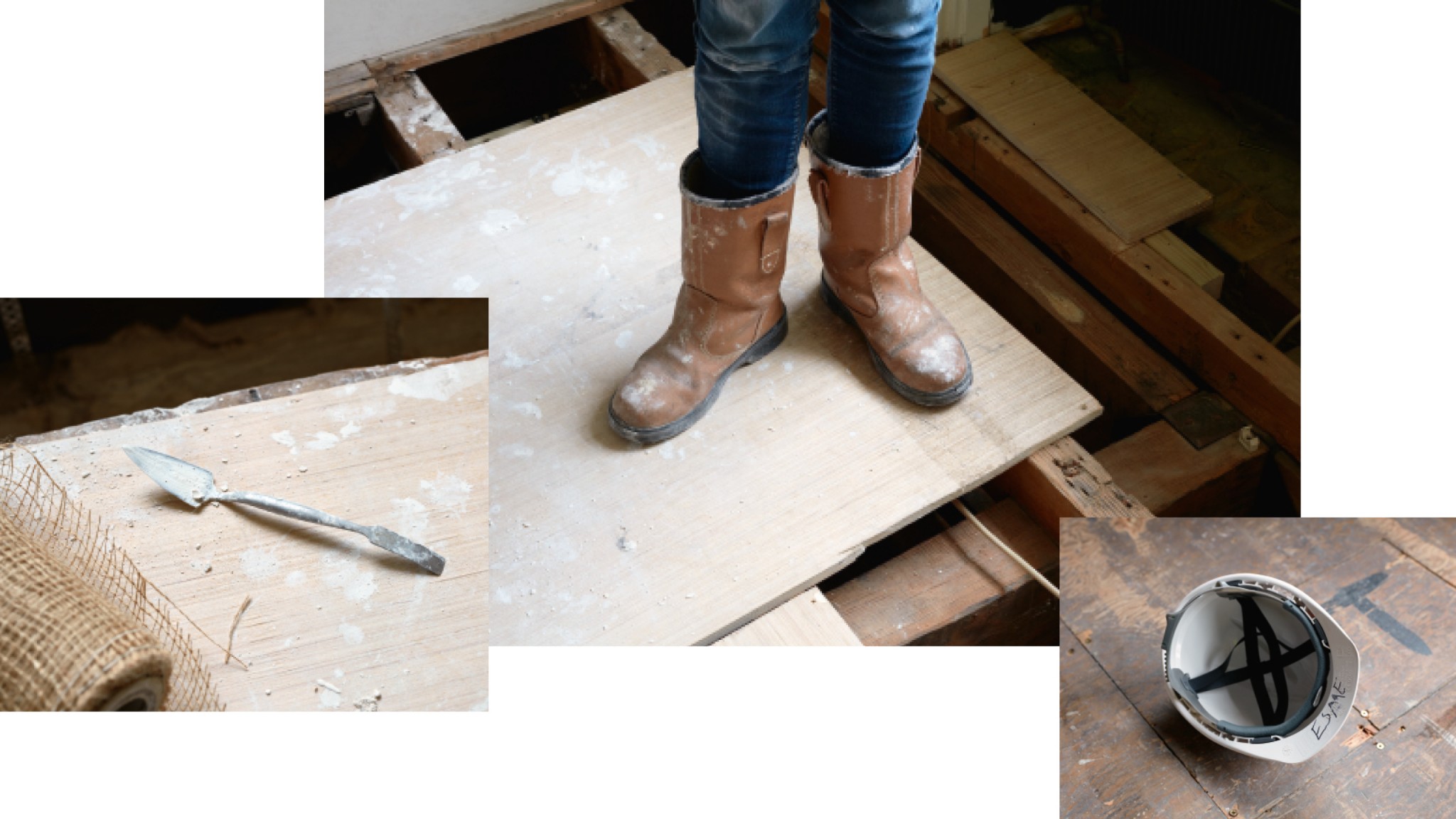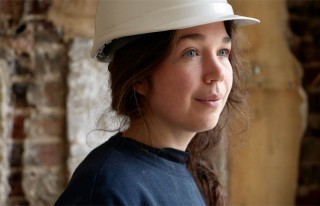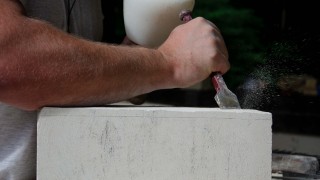Journal 25 February 2019
The next steps for Craft Build student Esme Walker
The Prince’s Foundation student Esme Walker is cementing her career in heritage building craft with a little help from Cliveden Conservation
Esme Walker greets us from the vertiginous ceiling of a listed 18th century London townhouse, where she’s repairing an elaborate upper cornice. Tall windows behind her look out at a scattering of dogs running through Green Park; to the south, Buckingham Palace looms through the leaves on the trees, which have turned a fiery kaleidoscope of autumn colours. The 27-year-old Lancashire-raised apprentice, clad in hard hat, boots and multiple layers of warm clothing, is currently in the thick of The Prince’s Foundation Building Craft programme, an intensive eight-month course that offers priceless hands-on experience in a range of traditional building skills, and the opportunity to work alongside expert master craftspeople. “I’ve learned so much just working on this particular building,” she says, gesturing to walls that tell a fascinating story of the changing tastes of the London elite. “It’s so interesting peeling away the layers. You can see all this wood carving on panels that were then covered over as new fashions came in. I’ve learned about modern fibrous plasterwork, and a lot about conserving older, more traditional plasterwork, too.”

So far the programme has taken her from a summer school split between London and Dumfries House Estate in Scotland – where she and fellow students built a pagoda extravagantly carved with birds, bees and curling vines – to her current placement with Cliveden Conservation, venerable experts in stone, plaster and the decorative arts who have worked on numerous country houses, National Trust properties, and, of course, the odd royal palace. Last week Walker was stripping back generations of paint in Grosvenor Square and today, as well as the aforementioned cornice, there’s the small problem of someone’s foot going through the ceiling, creating a hole in the room below; learning to expect the unexpected will no doubt come in useful in her chosen niche of plasterwork.
Walker’s epiphany came during a summer internship restoring a hilltop villa in Majorca, taught by a stone mason versed in sustainable building and traditional methods. Prior to that, she had completed a degree in town planning. “That summer was an introduction to dry stone walling, a bit of stone carving, a lot of lime rendering and moving statues around – a well rounded idea of how to restore properties,” she says. “lt was so interesting to see how those traditional methods are still relevant today, and how much we can learn from them. When I got back, I found the programme and went away to get the experience I needed to apply.” She headed to North Wales, doing the woodwork and lime rendering typical of that area, and volunteered on projects including the restoration of a 16th century barn, which involved living in mud huts, cooking over campfires, and learning the benefits of wool when it comes to keeping out the damp and cold.
“the scheme offers unique access to the mentorship of experts”
For Walker, The Prince’s Foundation scheme offered unique access to the mentorship of experts with decades of wisdom to impart. “Last year I took on some self-employed projects and it made me realise there’s only so much you can get from the literature,” she says. “It’s the first-hand experience that is so useful. On this course they really take you under their wing.” Supervising proceedings today is Lewis Proudfoot, who is Manager of the stone section at Cliveden Conservation, a company with a 30-year history of restoring heritage sites, from a ruined folly at Wimpole Hall in Cambridgeshire, to the rafters of Oxford’s Christ Church college’s famous Great Hall, which they prevented from crashing down on unsuspecting students’ heads.

Proudfoot got an early education in the crafts from his father, Cliveden’s Managing Director: “I remember going up on the scaffolds at Hampton Court when I was young, seeing a team of people working on a beautiful façade, and feeling the camaraderie among workers,” he says. “It’s a privilege to be part of this.” Proudfoot is also an alumni of The Prince’s Foundation course, and now Cliveden Conservation aims to take a couple of students each year from the scheme: “I think people are aware of the importance of passing these skills along to the next generation, but the set-up isn’t always there,” he says. “That’s where The Prince’s Foundation programme is so good; it’s a concentrated burst of support. A lot of it is confidence in yourself. You go up to Dumfries House, get chucked in at the deep end, and realise you can do it. It gives young people a huge step up in starting their careers.”
Attracting young people – young women in particular – will be vital in preserving these precious skills, and while building sites aren’t known for their gender equality, Walker says that is changing. “I once signed up for a plastering evening course, and all the guys would load up my table with mix, and say ‘don’t feel uncomfortable’ – they were very encouraging, but it was apparent that it was quite a big deal!” she says with a laugh. “But I’ve found there are a lot of women in the wet trades like plastering, which is interesting, because it’s labour-intensive. I heard of a woman working at a National Trust property who would go down to the river and collect sand, dry it and use it on the project. Quite a few women do this heritage plasterwork and get really into it.”
The wide range of people Walker encounters everyday and the itinerant nature of her trade is part of its appeal, she says – one guarantee of life in the heritage arts is its constant variation, mixed with more steady satisfactions that come with the slow-burning methods of a master artisan. Case in point; the delicate work on the cornice still has a way to go as we prepare to leave. “People say to me, what if you knock off a nose when you’re carving? But it never gets to that, because it’s a slow process. It’s the same with plasterwork,” says Proudfoot, indicating Walker atop the scaffolding. “There’s a meditative element to it, a constant improvement you can see in the work you’re doing. It gives you time to think.” And that might be the ultimate luxury in this digital age of ours. “Right,” Proudfoot nods, “you can’t be on your iPhone when you’ve got a trowel in your hand.”





